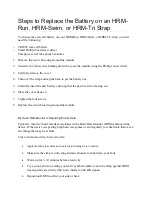
Operation
ALARMS
The SZ1145 generates an "Alarm Condition" whenever
any of the four RTD inputs, any of the two 4-20mA ana-
log inputs or any of the two digital inputs have been
programmed to generate an alarm, and that respective
input is in alarm. An "Alarm" occurs when an RTD or
analog input exceeds the high limit setting or falls below
the low limit setting, or when a digital input opens (clos-
es). Whenever an "Alarm Condition" occurs, the main
monitoring screen shows CHECK indicating that an
alarm is present. Keep in mind that any or all of these
inputs can be used for monitoring purposes when alarm-
ing is disabled.
RTD INPUTS
There are four 1000
Ω
PtRTD inputs available. Each
one is scaled 20 to 120°F (-6.7 to 48.9°C) and cannot
be changed. Each input (TEMP1, TEMP2, TEMP3 &
TEMP4) can be enabled to generate an alarm. Once
enabled, you need to set a "High Limit", a "Low Limit"
and a "Hysteresis" (in degrees). When the temperature
reaches the High or Low limit, an alarm is generated.
The alarm is automatically cleared when the tem-
perature falls from the High Limit by the amount of the
Hysteresis (for a High Alarm Condition) or when the
temperature rises from the Low Limit by the amount of
the Hysteresis (for a Low Alarm Condition).
Note:
If a High Limit is set to 120°F, it is disabled. If a
Low Limit is set to 20°F, it is also disabled.
ANALOG INPUTS
There are also two 4-20mA inputs available. These two
inputs can be used to generate an alarm based on any
4-20mA signal.
The analog inputs need to be scaled, i.e. the SPAN
LOW LIMIT is the value at 4mA and the SPAN HIGH
LIMIT is the value at 20mA. The Low and High limits
are adjustable from -200 to 800. A decimal point can
be turned on also. The decimal point is for display pur-
poses only on the SZ1145 display. For example if you
are sensing differential pressure from 0 to 1", you could
scale the analog input to be 0 to 100 and then turn on
R
2800 LAURA LANE • MIDDLETON, WI 53562 • (800) 288-9383 • FAX (608) 836-9044 • www.tcsbasys.com
5
Alarm Delay Wait Increment.
Select
the desired increment (15 seconds or 1
minute) for the Alarm Delay Wait Time.
Alarm Delay Wait Time Screen.
Set
the amount of time that an analog alarm
condition (Temp1-4, AI1&2) must be pres-
ent before actually generating the alarm.
The time is adjustable in 15 second incre-
ments from 0 minutes and 0 seconds to
63 minutes and 45 seconds.
Digital Input 1 Mode Screen.
Choose
DI1 as MONITOR, ALARM or TOGGLE
MOMENTARY. Select MONITOR if
unused.
Digital Input 1 Alarm Mode Screen.
Choose OPEN or CLOSED as the condi-
tion which will trigger the DI1 alarm. This
screen only appears if the DI1 mode is
set to ALARM.
Digital Input 1 Override Delay Screen.
Set the override time (0 to 255 minutes)
that will be used when DI1 is activated
with a momentary contact. This screen
only appears if the DI1 mode is set to
TOGGLE MOMENTARY.
Digital Input 2 Mode Screen.
Choose
DI2 as MONITOR or ALARM. Select
MONITOR if unused.
Digital Input 2 Alarm Mode Screen.
Choose OPEN or CLOSED as the condi-
tion which will trigger the DI2 alarm. This
screen only appears if the DI2 mode is
set to ALARM.
15 Second DI Delay Screen.
Used to
indicate whether to apply a 15 second
delay to the digital inputs, before recog-
nizing an alarm condition. This screen is
only shown if the mode for either DI1 or
DI2 is set to ALARM.
Alarm Relay Output Mode Screen.
Choose whether to have the relay output
be OPEN or CLOSED when in alarm, or
choose DISABLE if the relay output is not
being used.
Automatic Alarm Time-out Screen.
Choose whether to allow the relay output
to automatically expire after a set amount
of time. This screen is not shown if the
Alarm Relay Output Mode Screen is set
to DISABLE.
Set Alarm Time-out Time Screen.
Enter
the time in seconds (0 to 255 seconds)
that the relay output should be active
before becoming inactive. This screen is
not shown if the Automatic Alarm Time-
out Screen is set to NO.
Access Code Screen.
Enter an access
code (0 to 255) that will be used to enter
the programming mode. The default is
248.
Main Monitoring Screen.
Low Limit
ON
Hysteresis
High Limit
ON
OFF
OFF
Hysteresis
ALARM DELAY WAIT
TIME 000MIN 00SEC
36.
DI USED FOR:
ALARM
37.
DI1 ALARM
WHEN: CLOSED
38.
SET OVERRIDE
TIME: 60 MINUTTES
39.
DI2 USED FOR:
ALARM
40.
DI2 ALARM
WHEN: CLOSED
41.
15 SEC DI DELAY
DISABLE
42.
ALARM OUTPUT
ACTIVE= CLOSED
43.
ALLOW ALARM
TIMEOUT? NO
44.
SET ALARM TIME -
OUT TIME: 00SEC
45.
SET ACCESS
CODE: 248
46.
ALARM STATUS
CHECK
ALARM DELAY WAIT
15 SEC
35.


























